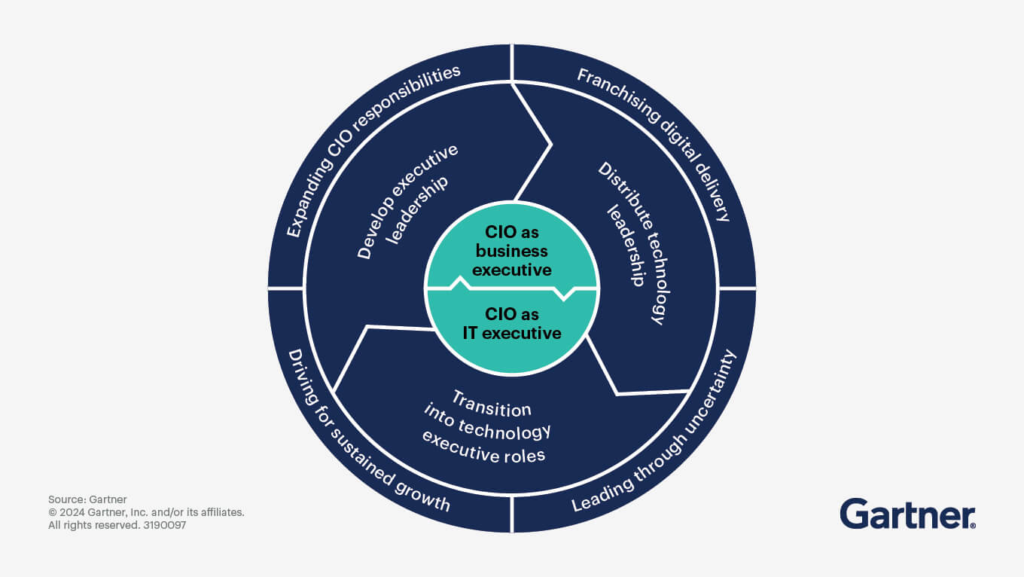

Summary
IT and business leaders face rising complexity—from fragmented toolchains and delayed innovation cycles to the urgent need for AI, data, and security strategies aligned with business outcomes.
This blog outlines how platform engineering can address these challenges by enabling unified environments, automating infrastructure provisioning, and empowering self-service across teams.
To move forward, organizations should reduce workflow fragmentation, implement secure, scalable developer platforms, align AI and data strategies with business goals, and adopt governance models that support agility.
The key takeaway: empowering cross-functional teams through modern platform thinking drives speed, security, and strategic value at scale.
In a constantly evolving digital landscape, business and IT leaders encounter a myriad of challenges akin to navigating a sea of change. From managing fragmented workflows to integrating advanced technologies like AI and machine learning, the demands for maintaining system stability and compliance are relentless.
The relentless pace of technological advancement, compounded by disparate tools and fragmented workflows, presents a formidable trial for even the most seasoned professionals.
By aligning IT capabilities with business goals, platform engineering emerges as a cornerstone for innovation and growth, streamlining operations, enhancing collaboration, and ensuring robust security.
IT Leaders: The plate spinners
- For IT leaders, their role demands maintaining oversight across diverse systems and processes, which are often complicated by a patchwork of incompatible tools. This fragmentation makes it difficult to implement standardized solutions that can operate harmoniously within the existing infrastructure.
- One of the most pressing duties for IT leaders is balancing the rapid introduction of new technologies with the imperative to maintain system stability and compliance.
- With the rise of AI and machine learning technologies, IT leaders are tasked with integrating these innovations while ensuring security and regulatory compliance, necessitating constant vigilance and proactive problem-solving. (See more on the top CIO challenges further below.)
Software engineers: caught in a web of complexity
- Software engineers often wait on infrastructure teams to provision environments that delay development cycles and impact project deadlines, perpetuating a cycle of inefficiency.
- The complexity of managing a fragmented toolchain and adhering to numerous security policies can be overwhelming, increasing the risk of inefficiencies and potential security breaches.
- Moreover, the constant necessity to adapt DevOps scripts and setups to keep pace with evolving standards and toolsets disrupts workflow and impedes productivity. A central challenge for software engineers is the difficulty in tracking and coordinating virtual project teams, which complicates monitoring progress and ensuring accountability.

Data engineers: Navigating the chaotic data landscape
- Data engineers implement data-driven strategies, yet they often face delays in accessing necessary infrastructure and data sources, hindering their ability to meet critical project timelines.
- The need to repeatedly perform manual, redundant tasks exacerbates inefficiencies and dampens overall job satisfaction.
- The fragmented data landscape makes it difficult for data engineers to maintain a unified and consistent view of organizational data.
- Ensuring data accuracy and consistency remains an ongoing challenge, undermining the effectiveness of data-driven initiatives. In an era where businesses increasingly rely on data to inform decisions, these obstacles can significantly hamper efforts to derive actionable insights.
- Similar to Software Engineers, Data Engineers face the challenge of adapting to DataOps practices. Like DevOps, DataOps involves making data readily available for development and testing, alongside other best practices from the DevOps methodology.
Business leaders: strategic navigators in a rapidly changing world
- Business leaders must deftly navigate rapid technological change while aligning their digital strategies with broader business objectives. This demands both agility and vision as leaders strive to deliver value quickly and sustainably, all while fostering a culture of innovation to maintain a competitive edge.
- The global nature of today’s market environment adds complexity, requiring leaders to be nimble in the face of volatility and to drive strategic initiatives that span geographical and cultural boundaries. This necessitates fostering cross-functional collaboration and aligning disparate teams towards common goals.
What are the CIO’s biggest challenges?
The role of the CIO is more challenging in 2025 than ever before. “The 2024 Gartner® CIO Agenda Survey[1] indicates that 80% of CIOs have expanded their role, with 18% leading non-IT functions and 10% leading P&L efforts.”
The Gartner CIO Report, which is based on research of over 12,000 global CIOs, examines five common CIO pain points.

Source: Gartner
According to Gartner, they are:
1. “How do I set an AI strategy, get started with use cases, and determine and realize measurable business value?”
As Gartner states, you want to “align the AI strategy with your business goals”. They continue: “Despite the outlandish AI hype, turning the promise of AI into reality is not a given: 49% of leaders highly involved in AI report that their organizations struggle to estimate and demonstrate the value of AI.”
The report also states: “Create an AI strategy revolving around a vision that is fully aligned with business goals, market conditions and competitive pressure regarding the use of AI. In addition, the AI strategy should identify key value opportunities as well as risks. Make the AI strategy executable by setting priorities for a portfolio of concrete business-related AI initiatives, and by setting planning goals to build and mature an AI operating model.”
2. “How do I create a realistic and effective data analytics strategy aligned to business goals, stakeholders, and use cases?”
In the aforementioned report, Gartner recommends: “CIOs looking to drive a modern and actionable D&A strategy that sets the right foundations and delivers business outcomes should focus on five key steps:
- Understand key business priorities and how D&A assets deliver business value; define how to govern these assets.
- Position D&A as a key enterprise asset, and evangelize its impact on critical business processes, decisions and outcomes.
- Forge relationships with key stakeholders across functions, and secure funding and executive leader support.
- Establish a current-state baseline/maturity assessment to serve as a foundation for continuous improvement and define the scope for D&A initiatives.
- Identify opportunities to monetize, exploit and govern data assets via prioritized use cases, and define the associated strategy, vision and roadmap.”
3. “How do I protect my organization from constantly evolving security threats?”
Gartner says: “To achieve a defensible security program, cybersecurity leaders should take the following actions:
- Ensure clear accountability for cybersecurity risk to enable effective risk-based control decisions.
- Build a program that reflects the unique business context of the organization, capitalizing on generally accepted standards and proven practices.
- Design the program for agility and continuous improvement by emphasizing key principles and formalizing security processes.”
4. “How do I demonstrate business value from technology investments?”
Gartner states: “CIOs looking to showcase the business value of IT investments need to focus on three key questions, as below:
- What do my stakeholders value? Value doesn’t lie in the technology itself but what the technology enables the business to do. Value comes from delivering business outcomes, which ultimately impact cost, risk or revenue.
- How do I build an IT value story? Differentiate value stories into “Run” (keep the lights on) and “Change” (improve business outcomes). The Run value narrative is about how maintaining high performance levels and sustaining the operational business facilitates business performance. The Change value story focuses on value added through expanding existing capabilities and delivering new ones.
- How can I effectively communicate value? Metrics, used to back up the value story narrative, form a key part of effective business value communications. To communicate value, CIOs need to explain how resolving those tickets, or maintaining those systems, helped stakeholders achieve their goals and improved business outcomes.”
5. “How do I design my organization and talent strategy for today’s challenges?”
As the Gartner report recommends: “CIOs focused on their organization’s culture and people who are seeking to attract and recruit top IT talent should take the following actions:
- Tap into the large pool of passive candidates in the IT labor market by leveraging tools such as social media platforms and employee referrals.
- Reimagine IT job descriptions by designing persuasive job postings that go beyond listing only the necessary skills and experiences required.
- Dispel candidates’ industry-specific preconceived assumptions by building and enhancing their IT departments’ brands.
- Preempt candidate ghosting by truly understanding what candidates seek and embedding that in the entire recruiting process.
- Champion implementation of new work patterns like radical flexibility, fully remote or hybrid — at the very least for critical IT skills — by educating peers and HR partners on the talent risks of a full return to on-site working.”
What’s the answer to these challenges?
In our view, there’s something that could provide a future-proof answer… Check out our next blog in this series to find out what that is!
In the meantime, why not view our other resources?
If you want to talk to one of our team to find out how Calibo can help you with your challenges, book a meeting with us here.
FAQ
Q: What are the biggest challenges IT and business leaders face in 2025?
Leaders are contending with fragmented workflows, complex toolchains, integrating AI responsibly, ensuring security and compliance, and aligning digital initiatives with fast-changing business needs—all while avoiding delays and inefficiencies.
Q: How are CIOs expected to deliver value through AI and data strategy?
CIOs must align AI and data initiatives with business goals, define measurable outcomes, secure stakeholder buy-in, and prioritize use cases that deliver value—while also building scalable operating models and governance structures.
Q: What’s the key to overcoming these enterprise challenges?
A platform engineering approach—featuring unified environments, automation, and self-service tools—can bridge gaps between IT and business, enabling teams to innovate faster while maintaining control, security, and agility.
[1] Gartner, “The Top CIO Challenges, According to 12k+ of Your CIO Peers”, By Chris Howard, 17 September 2024. GARTNER is a registered trademark and service mark of Gartner, Inc. and/or its affiliates in the U.S. and internationally and is used herein with permission. All rights reserved.
Trending articles

Data orchestration: why modern enterprises need a data orchestration platform
Data is pouring in from myriad sources—cloud applications, IoT sensors, customer interactions, legacy databases—yet without proper coordination, much of it remains untapped potential. This is where data orchestration comes in.

How Enterprise Architects can get more support for technology led innovation
Enterprise Architects are increasingly vital as guides for technology-led innovation, but they often struggle with obstacles like siloed teams, misaligned priorities, outdated governance, and unclear strategic value. The blog outlines six core challenges—stakeholder engagement, tool selection, IT-business integration, security compliance, operational balance, and sustaining innovation—and offers a proactive roadmap: embrace a “fail fast, learn fast” mindset; align product roadmaps with enterprise architecture; build shared, modular platforms; and adopt agile governance supported by orchestration tooling.

Why combine an Internal Developer Portal and a Data Fabric Studio?
Discover how to combine Internal Developer Portal and Data Fabric for enhanced efficiency in software development and data engineering.

The differences between data mesh vs data fabric
Explore the differences of data mesh data fabric and discover how these concepts shape the evolving tech landscape.

More from Calibo
One platform, whether you’re in data or digital.
Find out more about our end-to-end enterprise solution.